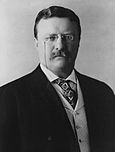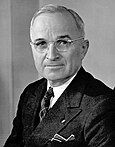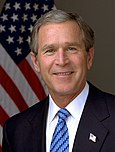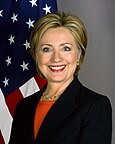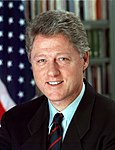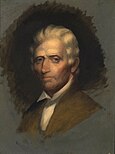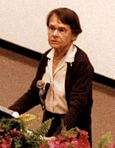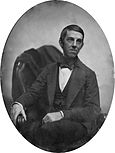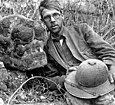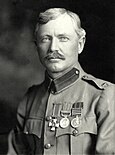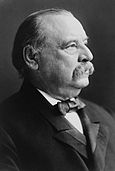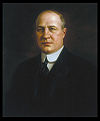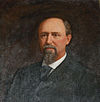Portal:United States/Selected biography
Selected society biographies list
1–25
Selected biography 1
</noinclude> Portal:United States/Selected biography/1
Samuel Adams (September 27 [O.S. September 16] 1722 – October 2, 1803) was an American statesman, politician, writer and political philosopher, brewer, and one of the Founding Fathers of the United States. Adams was instrumental in garnering the support of the colonies for rebellion against Great Britain, eventually resulting in the American Revolution, and was also one of the key architects of the principles of American republicanism that shaped American political culture.Born in Boston, Massachusetts, Adams was brought up in a religious and politically active family. After being educated at Boston Latin School and Harvard College, Adams became a mercantile businessman, but this proved not to be his vocation and he soon turned to politics, and became an influential political writer and theorist. Adams established himself as one of the voices of opposition to British control in the colonies; he argued that the colonies should withdraw from Great Britain and form a new government. Adams called for the colonists to defend their rights and liberties, and led town meetings in which he drafted written protests against Parliament's colonial tax measures such as the Stamp Act of 1765. Adams played a prominent role during protests against the Stamp Act, and in the events of the Boston Tea Party in 1773. He participated in the Continental Congress. He also advocated the adoption of the Declaration of Independence at the Second Continental Congress.
Selected biography 2
</noinclude> Portal:United States/Selected biography/2
John Calvin Coolidge, Jr. (July 4, 1872 – January 5, 1933), more commonly known as Calvin Coolidge, was the thirtieth President of the United States (1923–1929). A Republican lawyer from Vermont, Coolidge worked his way up the ladder of Massachusetts state politics, eventually becoming governor of that state. His actions during the Boston Police Strike of 1919 thrust him into the national spotlight. Soon after, he was elected as the twenty-ninth Vice President in 1920 and succeeded to the Presidency upon the death of Warren G. Harding. Elected in his own right in 1924, he gained a reputation as a small-government conservative.In many ways Coolidge's style of governance was a throwback to the passive presidency of the nineteenth century. He restored public confidence in the White House after the scandals of his predecessor's administration, and left office with considerable popularity. As his biographer later put it, "he embodied the spirit and hopes of the middle class, could interpret their longings and express their opinions. That he did represent the genius of the average is the most convincing proof of his strength."
Selected biography 3
</noinclude> Portal:United States/Selected biography/3
Gerald Rudolph Ford Jr. (July 14, 1913 – December 26, 2006) was the thirty-eighth President of the United States, serving from 1974 to 1977, and the fortieth Vice President of the United States serving from 1973 to 1974. He was the first person appointed to the vice presidency under the terms of the 25th Amendment, and became President upon Richard Nixon's resignation on August 9, 1974. Ford was the fifth U.S. President never to be elected for the position of President, but the only U.S. President to not even be elected as Vice President or President.As president, Ford signed the Helsinki Accords, marking a move toward détente in the Cold War, even as South Vietnam, a former ally, was invaded and conquered by North Vietnam. Ford did not intervene in Vietnamese affairs, but did help extract friends of the U.S. Domestically, the economy suffered from inflation and a recession under President Ford. One of his more controversial decisions was granting a presidential pardon to President Richard Nixon for his role in the Watergate scandal. In 1976, Ford narrowly defeated Ronald Reagan for the Republican nomination, but ultimately lost the presidential election to Democrat Jimmy Carter.
Selected biography 4
</noinclude> Portal:United States/Selected biography/4
Barack Hussein Obama, Jr. (born August 4, 1961) was the 44th President of the United States. He is the first African American to hold the office. Obama previously served as a United States Senator from Illinois, from January 2005 until he resigned after his election to the presidency in November 2008.A native of Honolulu, Hawaii, Obama is a graduate of Columbia University and Harvard Law School, where he was the president of the Harvard Law Review. He was a community organizer in Chicago before earning his law degree. He worked as a civil rights attorney in Chicago and taught constitutional law at the University of Chicago Law School from 1992 to 2004.
As president, Obama signed economic stimulus legislation in the form of the American Recovery and Reinvestment Act in February 2009 and the Tax Relief, Unemployment Insurance Reauthorization, and Job Creation Act of 2010 in December 2010. Other domestic policy initiatives include the Patient Protection and Affordable Care Act, the Dodd–Frank Wall Street Reform and Consumer Protection Act and the Don't Ask, Don't Tell Repeal Act of 2010. In foreign policy, Obama gradually withdrew combat troops from Iraq, increased troop levels in Afghanistan, and signed an arms control treaty with Russia. In October 2009, Obama was named the 2009 Nobel Peace Prize laureate.
Selected biography 5
</noinclude> Portal:United States/Selected biography/5
Rosa Parks (February 4, 1913 – October 24, 2005) was an African American civil rights activist whom the U.S. Congress later called "Mother of the Modern-Day Civil Rights Movement".On December 1, 1955, Parks became famous for refusing to obey bus driver James Blake's order that she give up her seat to make room for a white passenger. This action of civil disobedience started the Montgomery bus boycott, which is one of the largest movements against racial segregation. In addition, this launched Martin Luther King Jr., who was involved with the boycott, to prominence in the civil rights movement. She has had a lasting legacy worldwide.
Although Parks' autobiography recounts that some of her earliest memories are of the kindness of white strangers, her situation made it impossible to ignore racism. When the Ku Klux Klan marched down the street in front of her house, Parks recalls her grandfather guarding the front door with a shotgun. The Montgomery Industrial School, founded and staffed by white northerners for black children, was burned twice by arsonists, and its faculty was ostracized by the white community.
Parks received most of her national accolades very late in life, with relatively few awards and honors being given to her until many decades after the Montgomery bus boycott. For example, the Rosa Parks Congressional Gold Medal bears the legend "Mother of the Modern Day Civil Rights Movement".
Selected biography 6
</noinclude> Portal:United States/Selected biography/6
Nancy Davis Reagan (born Anne Frances Robbins on July 6, 1921) is the widow of former United States President Ronald Reagan and was First Lady of the United States from 1981 to 1989. Born in New York, her parents divorced soon after her birth; she grew up in Maryland, living with an aunt and uncle while her mother pursued acting jobs. As Nancy Davis, she was an actress in the 1940s and 1950s, starring in films such as Donovan's Brain, Night into Morning, and Hellcats of the Navy. In 1952 she married Ronald Reagan, who was then president of the Screen Actors Guild; they had two children. Nancy became the First Lady of California when her husband was Governor from 1967 to 1975.She became the First Lady of the United States in January 1981 following her husband's victory, but experienced criticism early in his first term largely due to her decision to replenish the White House china. Nancy restored a Kennedy-esque glamor to the White House following years of lax formality, and her interest in high-end fashion garnered much attention as well as criticism for accepting unreported loans and gifts from fashion designers. She championed recreational drug prevention causes by founding the "Just Say No" drug awareness campaign, which was considered her major initiative as First Lady. More controversy ensued when it was revealed in 1988 that she had consulted an astrologer to assist in planning the president's schedule after the 1981 assassination attempt on her husband's life.
Selected biography 7
</noinclude> Portal:United States/Selected biography/7
Ronald Wilson Reagan (February 6, 1911 – June 5, 2004) was the 40th President of the United States (1981–1989) and the 33rd Governor of California (1967–1975). Born in Illinois, Reagan moved to Los Angeles, California in the 1930s, where he became an actor, president of the Screen Actors Guild (SAG), and a spokesman for General Electric (GE). His start in politics occurred during his work for GE; originally a member of the Democratic Party, he switched to the Republican Party in 1962. After delivering a rousing speech in support of Barry Goldwater's presidential candidacy in 1964, he was persuaded to seek the California governorship, winning two years later and again in 1970. He was defeated in his run for the Republican presidential nomination in 1968 as well as 1976, but won both the nomination and election in 1980.As president, Reagan implemented new political initiatives as well as economic policies, advocating a laissez-faire philosophy, but the extent to which these ideas were implemented is debatable. The supply side economic policies, dubbed "Reaganomics", included substantial tax cuts implemented in 1981. After surviving an assassination attempt and ordering controversial military actions in Grenada, he was re-elected in a landslide victory in 1984.
Selected biography 8
</noinclude> Portal:United States/Selected biography/8
Franklin Delano Roosevelt (January 30, 1882 – April 12, 1945), often referred to by his initials FDR, was the thirty-second President of the United States. Elected to four terms in office, he served from 1933 to 1945, and is the only U.S. president to have served more than two terms of office. He was a central figure of the 20th century during a time of worldwide economic crisis and world war.During the Great Depression of the 1930s, Roosevelt created the New Deal to provide relief for the unemployed, recovery of the economy, and reform of the economic and banking systems. Although recovery of the economy was incomplete until almost 1940, many programs initiated continue to have instrumental roles in the nation's commerce, such as the FDIC, TVA, and the SEC. One of his most important legacies is the Social Security system.
Roosevelt won four presidential elections in a row, causing a realignment political scientists call the Fifth Party System. His aggressive use of the federal government re-energized the Democratic Party, creating a New Deal Coalition which dominated American politics until the late 1960s. He and his wife, Eleanor Roosevelt, remain touchstones for modern American liberalism. Conservatives vehemently fought back, but Roosevelt usually prevailed until he tried to pack the Supreme Court in 1937. Thereafter, the new Conservative coalition successfully ended New Deal expansion; during the war it closed most relief programs like the WPA and Civilian Conservation Corps, arguing unemployment had disappeared.
Selected biography 9
</noinclude> Portal:United States/Selected biography/9
Theodore Roosevelt, Jr. (/ˈroʊzəvɛlt/; October 27, 1858 – January 6, 1919), also known as T.R., and to the public (but never to friends and intimates) as Teddy, was the twenty-sixth President of the United States, and a leader of the Republican Party and of the Progressive Movement. He became President of the United States at the age of 42. He served in many roles including Governor of New York, historian, naturalist, explorer, author, and soldier. Roosevelt is most famous for his personality: his energy, his vast range of interests and achievements, his model of masculinity, and his "cowboy" persona. Roosevelt prided himself on being a rough and tumbled man. This was partly because as a child he suffered from sever asthma. As he outgrew his ailments he took on masculine challenges such as boxing, wrestling, and of course, his favorite pastime, hunting. His last name, often mispronounced, is, per Roosevelt, "pronounced as if it were spelled "Rosavelt"— in three syllables, the first syllable as "Rose."As Assistant Secretary of the Navy, Roosevelt prepared for and advocated war with Spain in 1898. He organized and helped command the 1st U.S. Volunteer Cavalry Regiment, the Rough Riders, during the Spanish–American War. Returning to New York as a war hero, he was elected Republican governor in 1899. He was a professional historian, a lawyer, a naturalist and explorer of the Amazon basin; his 35 books include works on outdoor life, natural history, the American frontier, political history, naval history, and his autobiography.
Selected biography 10
</noinclude> Portal:United States/Selected biography/10
Harry S. Truman (May 8, 1884 – December 26, 1972) was the thirty-third President of the United States (1945–1953). As vice president, he succeeded to the office upon the death of Franklin D. Roosevelt.During World War I he served as an artillery officer. After the war he became part of the political machine of Tom Pendergast and was elected a county judge in Missouri and eventually a United States Senator. In 1945, Roosevelt replaced Henry A. Wallace as vice president with Truman for Roosevelt's fourth term.
As president, Truman faced challenge after challenge in domestic affairs. The tumultuous reconversion of the economy of the United States was marked by severe shortages, numerous strikes, and the passage of the Taft–Hartley Act over his veto. He confounded all predictions to win re-election in 1948, largely due to his famous Whistle Stop Tour of rural America. After his re-election he was able to pass only one of the proposals in his Fair Deal program. He used executive orders to begin desegregation of the U.S. armed forces and to launch a system of loyalty checks to remove thousands of communist sympathizers from government office, even though he strongly opposed mandatory loyalty oaths for governmental employees, a stance that led to charges that his administration was soft on communism. Truman's presidency was also eventful in foreign affairs, with the end of World War II and his decision to use nuclear weapons in combat, the founding of the United Nations, the Marshall Plan to rebuild Europe, the Truman Doctrine to contain communism, the beginning of the Cold War, the creation of NATO, and the Korean War. Corruption in Truman's administration reached the cabinet and senior White House staff. Republicans made corruption a central issue in the 1952 campaign.
Selected biography 11
</noinclude> Portal:United States/Selected biography/11
George Walker Bush (born July 6, 1946) is an American politician and businessman who served as the 43rd president of the United States from 2001 to 2009. A member of the Republican Party, he previously served as the 46th governor of Texas from 1995 to 2000.The eldest son of the 41st president George H. W. Bush and a member of the Bush family, he flew warplanes in the Texas Air National Guard in his twenties. After graduating from Harvard Business School in 1975, he worked in the oil industry. He later co-owned the Texas Rangers of Major League Baseball before being elected governor of Texas in 1994. As governor, Bush successfully sponsored legislation for tort reform, increased education funding, set higher standards for schools, and reformed the criminal justice system. He also helped make Texas the country's leading producer of wind-powered electricity. In the 2000 United States presidential election, he won over Democratic incumbent Vice President Al Gore, despite losing the popular vote after a narrow and contested Electoral College win that involved a Supreme Court decision to stop a recount in Florida. (Full article...)
Selected biography 12
</noinclude> Portal:United States/Selected biography/12
Hillary Diane Rodham Clinton (née Rodham; born October 26, 1947) is an American politician and diplomat who served as the 67th United States secretary of state in the administration of Barack Obama from 2009 to 2013, as a U.S. senator representing New York from 2001 to 2009, and as the first lady of the U.S. to president Bill Clinton from 1993 to 2001. A member of the Democratic Party, she was the party's nominee in the 2016 U.S. presidential election, becoming the first woman to win a presidential nomination by a major U.S. political party and the first woman to win the popular vote for U.S. president.Raised in Park Ridge, Illinois, Rodham graduated from Wellesley College in 1969 and from Yale Law School in 1973. After serving as a congressional legal counsel, she moved to Arkansas and, in 1975, married Bill Clinton, whom she had met at Yale. In 1977, Clinton co-founded Arkansas Advocates for Children and Families. She was appointed the first female chair of the Legal Services Corporation in 1978 and became the first woman partner at Little Rock's Rose Law Firm the following year. The National Law Journal twice listed her as one of the hundred most influential lawyers in America. Clinton was the first lady of Arkansas from 1979 to 1981 and again from 1983 to 1992. As the first lady of the U.S., Clinton advocated for healthcare reform. In 1994, her health care plan failed to gain approval from Congress. In 1997 and 1999, Clinton played a leading role in advocating the creation of the State Children's Health Insurance Program, the Adoption and Safe Families Act, and the Foster Care Independence Act. She also advocated for gender equality at the 1995 World Conference on Women. In 1998, Clinton's marital relationship came under public scrutiny during the Lewinsky scandal, which led her to issue a statement that reaffirmed her commitment to the marriage. (Full article...)
Selected biography 13
</noinclude> Portal:United States/Selected biography/13
William Jefferson Clinton (né Blythe III; born August 19, 1946) is an American politician who served as the 42nd president of the United States from 1993 to 2001. A member of the Democratic Party, he previously served as Governor of Arkansas from 1979 to 1981 and again from 1983 to 1992. Clinton, whose policies reflected a centrist "Third Way" political philosophy, became known as a New Democrat.Clinton was born and raised in Arkansas. He graduated from Georgetown University in 1968, and later from Yale Law School, where he met his future wife, Hillary Rodham. After graduating from law school, Clinton returned to Arkansas and won election as state attorney general, followed by two non-consecutive tenures as Arkansas governor. As governor, he overhauled the state's education system and served as chairman of the National Governors Association. Clinton was elected president in the 1992 election, defeating the incumbent Republican Party president George H. W. Bush and the independent businessman Ross Perot. He became the first president to be born in the Baby Boomer generation. (Full article...)
Selected biography 14
</noinclude> Portal:United States/Selected biography/14
Edward Moore "Ted" Kennedy (February 22, 1932 – August 25, 2009) was a United States Senator from Massachusetts and a member of the Democratic Party. First elected in November 1962, he was elected nine times and served for 46 years in the U.S. Senate. At the time of his death, he was the second most senior member of the Senate, and the third-longest-serving senator in U.S. history. For many years the most prominent living member of the Kennedy family, he was the son of Joseph P. Kennedy Sr., the youngest brother of President John F. Kennedy and Senator Robert F. Kennedy, both victims of assassinations, and the father of Congressman Patrick J. Kennedy.Selected biography 15
</noinclude> Portal:United States/Selected biography/15
Thelma Catherine Ryan "Pat" Nixon (March 16, 1912 – June 22, 1993) was the wife of former President Richard Nixon and the First Lady of the United States from 1969 to 1974. She was commonly known as Pat Nixon.As First Lady, Pat Nixon promoted a number of charitable causes including volunteerism and oversaw the collection of more than 600 examples of historic art and furnishings for the White House, an acquisition larger than that of any other administration. She also encouraged women to run for political offices and became the most traveled First Lady in U.S. history up to that time, visiting about eighty nations; she was the first First Lady to visit a combat zone. Pat's tenure ended when, after being re-elected in the landslide victory of 1972, President Nixon resigned two years later amidst the Watergate scandal.
Pat's public appearances became rarer in her later life. She suffered two strokes within ten years of returning to California and was later diagnosed with lung cancer. She died in 1993.
Selected biography 16
</noinclude> Portal:United States/Selected biography/16
Michelle LaVaughn Obama (née Robinson; born January 17, 1964) is an American attorney and author who served as the first lady of the United States from 2009 to 2017, being married to former president Barack Obama.Raised on the South Side of Chicago, Obama is a graduate of Princeton University and Harvard Law School. In her early legal career, she worked at the law firm Sidley Austin where she met her future husband. She subsequently worked in nonprofits and as the associate dean of Student Services at the University of Chicago. Later she served as vice president for Community and External Affairs of the University of Chicago Medical Center. Michelle married Barack in 1992 and they have two daughters. (Full article...)
Selected biography 17
</noinclude> Portal:United States/Selected biography/17
George Washington (February 22, 1732 – December 14, 1799) was the first President of the United States, (1789–1797), after leading the Continental Army to victory over the Kingdom of Great Britain in the American Revolutionary War (1775–1783).Washington was chosen to be the commander-in-chief of the American revolutionary forces in 1775. The following year, he forced the British out of Boston, but was defeated when he lost New York City later that year. He revived the patriot cause, however, by crossing the Delaware River in New Jersey and defeating the surprised enemy units. As a result of his strategy, Revolutionary forces captured the two main British combat armies — Saratoga and Yorktown. Negotiating with Congress, the colonial states, and French allies, he held together a tenuous army and a fragile nation amid the threats of disintegration and failure. Following the end of the war in 1783, Washington retired to his plantation on Mount Vernon.
Selected biography 18
</noinclude> Portal:United States/Selected biography/18
John Sidney McCain III (August 29, 1936 – August 25, 2018) was an American politician and United States Navy officer who served as a United States senator from Arizona from 1987 until his death in 2018. He previously served two terms in the United States House of Representatives and was the Republican nominee for president of the United States in the 2008 election, which he lost to Barack Obama.McCain was a son of Admiral John S. McCain Jr. and grandson of Admiral John S. McCain Sr. He graduated from the United States Naval Academy in 1958 and received a commission in the United States Navy. McCain became a naval aviator and flew ground-attack aircraft from aircraft carriers. During the Vietnam War, he almost died in the 1967 USS Forrestal fire. While on a bombing mission during Operation Rolling Thunder over Hanoi in October 1967, McCain was shot down, seriously injured, and captured by the North Vietnamese. He was a prisoner of war until 1973. McCain experienced episodes of torture and refused an out-of-sequence early release. During the war, he sustained wounds that left him with lifelong physical disabilities. McCain retired from the Navy as a captain in 1981 and moved to Arizona. (Full article...)
Selected biography 19
</noinclude> Portal:United States/Selected biography/19
Daniel Boone was an American pioneer and hunter whose frontier exploits made him one of the first folk heroes of the United States. Boone is most famous for his exploration and settlement of what is now the U.S. state of Kentucky. Despite resistance from American Indians, for whom Kentucky was a traditional hunting ground, in 1775 Boone blazed the Wilderness Road through the Cumberland Gap and into Kentucky. There he founded Boonesborough, one of the first English-speaking settlements beyond the Appalachian Mountains. Before the end of the 18th century, more than 200,000 people entered Kentucky by following the route marked by Boone.Boone was a militia officer during the American Revolutionary War, which in Kentucky was fought primarily between settlers and British-allied American Indians. Boone was captured by Shawnees in 1778 and adopted into the tribe, but he escaped and continued to help defend the Kentucky settlements. He was elected to the first of his three terms in the Virginia General Assembly during the war, and fought in the Battle of Blue Licks in 1782, one of the last battles of the American Revolution. Boone worked as a surveyor and merchant after the war, but he went deep into debt as a Kentucky land speculator. Frustrated with legal problems resulting from his land claims, in 1799 Boone resettled in Missouri, where he spent his final years.
Selected biography 20
</noinclude> Portal:United States/Selected biography/20
Jim Bowie played a prominent role in the Texas Revolution, culminating in his death at the Battle of the Alamo. Countless stories of him as a fighter and frontiersman, both real and fictitious, have made him a legendary figure in Texas history.His rise to fame began in 1827 on reports of the Sandbar Fight. What began as a duel between two other men deteriorated into a melee in which Bowie, having been shot and stabbed, killed the sheriff of Rapides Parish with a large knife. This and other stories of Bowie's prowess with the knife led to the widespread popularity of the Bowie knife.
Bowie's reputation was cemented by his role in the Texas Revolution. After moving to Texas in 1830, Bowie became a Mexican citizen and married the daughter of the vice governor of the province. At the outbreak of the Texas Revolution, Bowie joined the Texas militia, leading forces at the Battle of Concepcion and the Grass Fight. In January 1836, he arrived at the Alamo, where he commanded the volunteer forces until an illness left him bedridden. Bowie died with the other Alamo defenders on March 6. Despite conflicting accounts of the manner of his death, the "most popular, and probably the most accurate" accounts maintain that he died in his bed after emptying his pistols into several Mexican soldiers.
Selected biography 21
</noinclude> Portal:United States/Selected biography/21
Winfield Scott Hancock was a career U.S. Army officer and the Democratic nominee for President of the United States in 1880. He served with distinction in the Army for four decades, including service in the Mexican–American War and as a Union general in the American Civil War. Known to his Army colleagues as "Hancock the Superb", he was noted in particular for his personal leadership at the Battle of Gettysburg in 1863. One military historian wrote, "No other Union general at Gettysburg dominated men by the sheer force of their presence more completely than Hancock." As another wrote, "his tactical skill had won him the quick admiration of adversaries who had come to know him as the 'Thunderbolt of the Army of the Potomac.'" His military service continued after the Civil War, as Hancock participated in the military Reconstruction of the South and the Army's presence at the Western frontier.After the Civil War, Hancock's reputation as a soldier and his dedication to conservative constitutional principles made him a quadrennial Presidential possibility. His noted integrity was a counterpoint to the corruption of the era. This nationwide popularity led the Democrats to nominate him for President in 1880. Although he ran a strong campaign, Hancock was defeated by Republican James Garfield by the closest popular vote margin in American history.
Selected biography 22
</noinclude> Portal:United States/Selected biography/22
Barbara McClintock (June 16, 1902 – September 2, 1992) was an American scientist and cytogeneticist who was awarded the 1983 Nobel Prize in Physiology or Medicine. McClintock received her PhD in botany from Cornell University in 1927. There she started her career as the leader of the development of maize cytogenetics, the focus of her research for the rest of her life. From the late 1920s, McClintock studied chromosomes and how they change during reproduction in maize. She developed the technique for visualizing maize chromosomes and used microscopic analysis to demonstrate many fundamental genetic ideas. One of those ideas was the notion of genetic recombination by crossing-over during meiosis—a mechanism by which chromosomes exchange information. She produced the first genetic map for maize, linking regions of the chromosome to physical traits. She demonstrated the role of the telomere and centromere, regions of the chromosome that are important in the conservation of genetic information. She was recognized as among the best in the field, awarded prestigious fellowships, and elected a member of the National Academy of Sciences in 1944.During the 1940s and 1950s, McClintock discovered transposons and used it to demonstrate that genes are responsible for turning physical characteristics on and off. She developed theories to explain the suppression and expression of genetic information from one generation of maize plants to the next. Due to skepticism of her research and its implications, she stopped publishing her data in 1953. (Full article...)
Selected biography 23
</noinclude> Portal:United States/Selected biography/23
Glynn S. Lunney (born November 27, 1936) is a retired NASA engineer. An employee of NASA since its foundation in 1958, Lunney was a flight director during the Gemini and Apollo programs, and was on duty during historic events such as the Apollo 11 lunar ascent and the pivotal hours of the Apollo 13 crisis. At the end of the Apollo program, he became manager of the Apollo-Soyuz Test Project, the first collaboration in spaceflight between the United States and the Soviet Union. Later, he served as manager of the Space Shuttle program before leaving NASA in 1985 and later becoming a Vice President of the United Space Alliance.Lunney was a pivotal figure in America's manned space program from Project Mercury through the coming of the Space Shuttle. He has received numerous awards for his work, including the National Space Trophy, which he was given by the Rotary Club in 2005. Chris Kraft, NASA's first flight director, described Lunney as "a true hero of the space age", saying that he was "one of the outstanding contributors to the exploration of space of the last four decades".
Selected biography 24
</noinclude> Portal:United States/Selected biography/24
Oliver Wendell Holmes, Sr. (August 29, 1809 – October 7, 1894) was an American physician, professor, lecturer, and author. Regarded by his peers as one of the best writers of the 19th century, he is considered a member of the Fireside Poets. His most famous prose works are the "Breakfast-Table" series, which began with The Autocrat of the Breakfast-Table (1858). He is recognized as an important medical reformer.Surrounded by Boston's literary elite—which included friends such as Ralph Waldo Emerson, Henry Wadsworth Longfellow, and James Russell Lowell—Holmes made an indelible imprint on the literary world of the 19th century. Many of his works were published in The Atlantic Monthly, a magazine that he named. For his literary achievements and other accomplishments, he was awarded numerous honorary degrees from universities around the world. Holmes's writing often commemorated his native Boston area, and much of it was meant to be humorous or conversational. Some of his medical writings, notably his 1843 essay regarding the contagiousness of puerperal fever, were considered innovative for their time. He was often called upon to issue occasional poetry, or poems written specifically for an event, including many occasions at Harvard. Holmes also popularized several terms, including "Boston Brahmin" and "anesthesia".
Selected biography 25
</noinclude> Portal:United States/Selected biography/25
Sylvanus Griswold Morley (June 7, 1883 – September 2, 1948) was an American archaeologist and epigrapher who studied the pre-Columbian Maya civilization in the early 20th century. Morley led extensive excavations of the Maya site of Chichen Itza on behalf of the Carnegie Institution and published several large compilations and treatises on Maya hieroglyphic writing. He also wrote popular accounts on the Maya for a general audience.To his contemporaries, "Vay" Morley was one of the leading Mesoamerican archaeologists of his day. Although more recent developments in the field have resulted in a re-evaluation of his theories and works, his publications, particularly on calendric inscriptions, are still cited. In his role as director of various projects sponsored by the Carnegie Institution, he oversaw and encouraged many others who later established notable careers in their own right. His commitment and enthusiasm for Maya studies helped inspire the necessary sponsorship for projects that would ultimately reveal much about ancient Maya civilization.
Morley also conducted espionage in Mexico on behalf of the United States during World War I, but the scope of those activities only came to light well after his death. His archaeological field work in Mexico and Central America provided suitable cover for his work with the United States' Office of Naval Intelligence investigating German activities and anti-American activity. (Full article...)
26–40
Selected biography 26
</noinclude> Portal:United States/Selected biography/26
Edward Teller (Hungarian: Teller Ede, January 15, 1908 – September 9, 2003) was a Hungarian-born American theoretical physicist, known colloquially as "the father of the hydrogen bomb," even though he did not care for the title. Teller emigrated to the United States in the 1930s, and was an early member of the Manhattan Project charged with developing the first atomic bombs.In his later years he became especially known for his advocacy of controversial technological solutions to both military and civilian problems, including a plan to excavate an artificial harbor in Alaska using thermonuclear explosives. He was a vigorous advocate of Ronald Reagan's Strategic Defense Initiative, perhaps overselling the feasibility of the program. Over the course of his life, Teller was known both for his scientific ability and his difficult interpersonal relations and volatile personality, and is considered one of the inspirations for the character Dr. Strangelove in the 1964 movie of the same name.
Selected biography 27
</noinclude> Portal:United States/Selected biography/27
William Tecumseh Sherman was an American soldier, businessman, educator, and author. He served as a general in the Union Army during the American Civil War, for which he received recognition for his outstanding command of military strategy and criticism for the harshness of the "scorched earth" policies that he implemented in conducting total war against the Confederate States.Sherman served under General Ulysses S. Grant in 1862 and 1863. In 1864, Sherman succeeded Grant as the Union commander in the western theater of the war. He proceeded to lead his troops to the capture of the city of Atlanta, a military success that contributed decisively to the re-election of President Abraham Lincoln. Sherman's subsequent march through Georgia and the Carolinas further undermined the Confederacy's ability to continue fighting.
After the Civil War, Sherman became Commanding General of the Army (1869–83). As such, he was responsible for the conduct of the Indian Wars in the western United States. He steadfastly refused to be drawn into politics and in 1875 published his Memoirs, one of the best-known firsthand accounts of the Civil War.
Selected biography 28
</noinclude> Portal:United States/Selected biography/28
Laura Lane Welch Bush (born November 4, 1946) is the wife of George W. Bush and served as the first lady of the United States from 2001 to 2009. Bush previously served as the first lady of Texas from 1995 to 2000.Born in Midland, Texas, Bush graduated from Southern Methodist University in 1968 with a bachelor's degree in education, and took a job as a second grade teacher. After attaining her master's degree in library science at the University of Texas at Austin, she was employed as a librarian.
Bush met her future husband, George W. Bush, in 1977, and they were married later that year. The couple had twin daughters in 1981. Bush's political involvement began during her marriage. She campaigned with her husband during his unsuccessful 1978 run for the United States Congress, and later for his successful Texas gubernatorial campaign.
As First Lady of Texas, Bush implemented many initiatives focused on health, education, and literacy. In 1999–2000, she aided her husband in campaigning for the presidency in a number of ways, such as delivering a keynote address at the 2000 Republican National Convention, which gained her national attention. She became First Lady after her husband was inaugurated as president on January 20, 2001. (Full article...)
Selected biography 29
</noinclude> Portal:United States/Selected biography/29
George Herbert Walker Bush (June 12, 1924 – November 30, 2018) was an American politician, diplomat, and businessman who served as the 41st president of the United States from 1989 to 1993. A member of the Republican Party, he also served as the 43rd vice president from 1981 to 1989 under Ronald Reagan, and in various other federal positions prior to that.Born into a wealthy, established family in Milton, Massachusetts, Bush was raised in Greenwich, Connecticut. He attended Phillips Academy and served as a pilot in the United States Navy Reserve during World War II before graduating from Yale and moving to West Texas, where he established a successful oil company. Following an unsuccessful run for the United States Senate in 1964, he was elected to represent Texas's 7th congressional district in 1966. President Richard Nixon appointed Bush as the ambassador to the United Nations in 1971 and as chairman of the Republican National Committee in 1973. President Gerald Ford appointed him as the chief of the Liaison Office to the People's Republic of China in 1974 and as the director of Central Intelligence in 1976. Bush ran for president in 1980 but was defeated in the Republican presidential primaries by Reagan, who then selected Bush as his vice presidential running mate. In the 1988 presidential election, Bush defeated Democrat Michael Dukakis.
Foreign policy drove Bush's presidency as he navigated the final years of the Cold War and played a key role in the reunification of Germany. He presided over the invasion of Panama and the Gulf War, ending the Iraqi occupation of Kuwait in the latter conflict. Though the agreement was not ratified until after he left office, Bush negotiated and signed the North American Free Trade Agreement, which created a trade bloc consisting of the United States, Canada and Mexico. Domestically, Bush reneged on a 1988 campaign promise by enacting legislation to raise taxes to justify reducing the budget deficit. He championed and signed three pieces of bipartisan legislation in 1990, the Americans with Disabilities Act, the Immigration Act and the Clean Air Act Amendments. He also appointed David Souter and Clarence Thomas to the Supreme Court. Bush lost the 1992 presidential election to Democrat Bill Clinton following an economic recession, his turnaround on his tax promise, and the increased emphasis of foreign policy in a post–Cold War political climate. (Full article...)
Selected biography 30
</noinclude> Portal:United States/Selected biography/30
Frederick Russell Burnham, DSO (May 11, 1861 – September 1, 1947) was an American scout and world traveling adventurer known for his service to the British Army in colonial Africa and for teaching woodcraft to Robert Baden-Powell, thus becoming one of the inspirations for the founding of the international Scouting Movement.Burnham had little formal education, attending high school but never graduating. He began his career at 14 in the American Southwest as a scout and tracker for the U.S. Army in the Apache Wars and Cheyenne Wars. Sensing the Old West was getting too tame, as an adult Burnham went to Africa where this background proved useful. He soon became an officer in the British Army, serving in several battles there. During this time, Burnham became friends with Baden-Powell, and passed on to him both his outdoor skills and his spirit for what would later become known as Scouting.
Burnham eventually moved on to become involved in espionage, oil, conservation, writing and business. His descendants are still active in Scouting.
Selected biography 31
</noinclude> Portal:United States/Selected biography/31
Stephen Grover Cleveland (March 18, 1837 – June 24, 1908) was the 22nd and 24th President of the United States. Cleveland is the only president to serve two non-consecutive terms (1885–1889 and 1893–1897) and therefore is the only individual to be counted twice in the numbering of the presidents. He was the winner of the popular vote for president three times—in 1884, 1888, and 1892—and was the only Democrat elected to the presidency in the era of Republican political domination that lasted from 1860 to 1912. Cleveland was the leader of the pro-business Bourbon Democrats who opposed high tariffs, free silver, inflation, imperialism and subsidies to business, farmers or veterans. His battles for political reform and fiscal conservatism made him an icon for American conservatives. His second term coincided with the Panic of 1893, a severe national depression that Cleveland was unable to reverse. It ruined his Democratic party, opening the way for Republican landslides in 1894 and 1896, and for the agrarian and silverite seizure of his Democratic party in 1896. Cleveland took strong positions and in turn took heavy criticism. His intervention in the Pullman Strike of 1894 to keep the railroads moving angered labor unions nationwide and angered the party in Illinois; his support of the gold standard and opposition to free silver alienated the agrarian wing of the Democratic Party. Biographer Allan Nevins wrote, "in Grover Cleveland the greatness lies in typical rather than unusual qualities. He had no endowments that thousands of men do not have. He possessed honesty, courage, firmness, independence, and common sense. But he possessed them to a degree other men do not."Selected biography 32
</noinclude> Portal:United States/Selected biography/32
Smedley Darlington Butler (July 30, 1881 – June 21, 1940), nicknamed "The Fighting Quaker" and "Old Gimlet Eye", was a Major General in the U.S. Marine Corps, and at the time of his death the most decorated Marine in U.S. history. During his 34-year career as a Marine, he participated in military actions in the Philippines, China, in Central America and the Caribbean during the Banana Wars, and France in World War I. By the end of his career he had received 16 medals, five of which were for heroism. He is one of 19 people to twice receive the Medal of Honor, one of three to be awarded both the Marine Corps Brevet Medal and the Medal of Honor, and the only person to be awarded the Brevet Medal and two Medals of Honor, all for separate actions.Butler continued his speaking engagements in an extended tour but in June 1940 checked himself into a naval hospital, dying a few weeks later from what was believed to be cancer. He was buried at Oaklands Cemetery in West Chester, Pennsylvania; his home has been maintained as a memorial and contains memorabilia collected during his various careers.
Selected biography 33
</noinclude> Portal:United States/Selected biography/33
Frank Woodruff Buckles (born Wood Buckles, February 1, 1901 – February 27, 2011) was a United States Army corporal and the last surviving American military veteran of World War I. He enlisted in the U.S. Army in 1917 aged 16 and served with a detachment from Fort Riley, driving ambulances and motorcycles near the front lines in Europe.
During World War II, then aged 40, he was captured by Japanese forces while working in the shipping business, and spent three years in the Philippines as a civilian prisoner. After the war, Buckles married in San Francisco and moved to Gap View Farm near Charles Town, West Virginia. A widower at age 98, he worked on his farm until the age of 105.
In his last years, he was honorary chairman of the World War I Memorial Foundation. As chairman, he advocated the establishment of a World War I memorial similar to other war memorials in Washington, D.C. Toward this end, Buckles campaigned for the District of Columbia War Memorial to be renamed the National World War I Memorial. He testified before Congress in support of this cause, and met with President George W. Bush at the White House. (Full article...)
Selected biography 34
</noinclude> Portal:United States/Selected biography/34
Edwin Taylor Pollock (1870–1943) was a career officer in the United States Navy, serving in both the Spanish–American War and World War I. As a young ensign, Pollock served on board USS New York during the Spanish–American War. After the war, he gradually rose through the ranks and served on many ships, including conducting important research into wireless communication. Less than a week before World War I, he won a race against a fellow officer to be the one to officially sign over the U.S. Virgin Islands from Denmark and serve as the territory's first acting-governor. During the war, he was promoted to captain and successfully transferred 60,000 American soldiers to France, for which he was awarded a Navy Cross. Subsequently, he was made the eighth Naval Governor of American Samoa and then the superintendent of the United States Naval Observatory, before retiring in 1927.Selected biography 35
</noinclude> Portal:United States/Selected biography/35
Edwin P. Morrow (1877–1935) served as the 40th Governor of Kentucky from 1919 to 1923. He was the only Republican elected to this office between 1907 and 1927. After rendering non-combat service in the Spanish–American War, Morrow graduated from the University of Cincinnati Law School in 1902 and opened his practice in Lexington, Kentucky. He was appointed United States Attorney for the Eastern District of Kentucky by President William Howard Taft in 1910 and served until he was removed from office in 1913 by President Woodrow Wilson. In 1915, he ran for governor against his good friend, Augustus O. Stanley. Stanley won the election by 471 votes, making the 1915 contest the closest gubernatorial race in the state's history. Morrow ran for governor again in 1919. He encouraged voters to "Right the Wrong of 1915" and ran on a progressive platform that included women's suffrage and quelling racial violence. He charged the Democratic administration with corruption, citing specific examples, and won the general election in a landslide. With a friendly legislature in 1920, he passed much of his agenda into law including an anti-lynching law and a reorganization of state government. By 1922, Democrats regained control of the General Assembly, and Morrow was not able to accomplish much in the second half of his term. Following his term as governor, he served on the United States Railroad Labor Board and the Railway Mediation Board.Selected biography 36
</noinclude> Portal:United States/Selected biography/36
Gerard K. O'Neill (1927–1992) was an American physicist and space activist. As a faculty member of Princeton University, he invented a device called the particle storage ring for high energy physics experiments. Later he invented a magnetic launcher called the mass driver. In the 1970s he developed a plan to build human settlements in outer space, including a space habitat design known as the O'Neill cylinder. He founded the Space Studies Institute, an organization devoted to funding research into space manufacturing and colonization. In 1965 at Stanford University he performed the first colliding beam physics experiment. While teaching physics at Princeton, O'Neill became interested in the possibility that humans could live in outer space. He researched and proposed a futuristic idea for human settlement in space, the O'Neill cylinder in "The Colonization of Space", his first paper on the subject. He held a conference on space manufacturing at Princeton in 1975. Many who became post-Apollo-era space activists attended. O'Neill built his first mass driver prototype with professor Henry Kolm in 1976. He considered mass drivers critical for extracting the mineral resources of the Moon and asteroids.Selected biography 37
</noinclude> Portal:United States/Selected biography/37
Murray Chotiner (1909–1974) was an American political strategist, attorney, government official, and close associate and friend of President Richard Nixon during much of Nixon's political career. He served as campaign manager for the future president's run for the United States Senate in 1950 and for his vice presidential bid in 1952, and managed the campaigns of other California Republicans. He was active in each of Nixon's two successful runs for the White House in low-profile positions. After Congress investigated Chotiner in 1956, suspecting the attorney was using his connections to Nixon for influence peddling to benefit his private clients, the Vice President and his former campaign manager temporarily parted ways. Nixon recalled him to work on his 1962 gubernatorial campaign and again for his successful 1968 presidential bid. After Nixon was inaugurated in 1969, Chotiner received a political appointment to a government position and, in 1970, became a member of the White House staff. He returned to private practice a year later, but was involved in Nixon's 1972 re-election campaign. He remained an informal adviser to Nixon until he died in Washington D.C. following an auto accident in January 1974, and Nixon mourned the loss of a man he described as a counselor and friend.Selected biography 38
</noinclude> Portal:United States/Selected biography/38
Lawrence Sullivan Ross (1838–1898) was the 19th Governor of Texas, a Confederate States Army general during the American Civil War, and a president of the Agricultural and Mechanical College of Texas. As a teenager, Ross attended Baylor University and Florence Wesleyan University. After graduation Ross became a Texas Ranger, and in 1860 led troops in the Battle of Pease River, where he rescued Cynthia Ann Parker, who had been captured by the Comanches as a child. When Texas joined the Confederacy, Ross joined the Confederate States Army. He participated in 135 battles and skirmishes and became one of the youngest Confederate generals. Following the Civil War, Ross briefly served as sheriff of McLennan County before resigning to participate in the 1875 Texas Constitutional Convention. With the exception of a two-year term as a state senator, Ross spent the next decade focused on his farm and ranch concerns. In 1887, he became the 19th governor of Texas. During his two terms, he oversaw the dedication of the new Texas State Capitol, resolved the Jaybird-Woodpecker War, and became the only Texas governor to call a special session to deal with a treasury surplus. Days after leaving office, Ross became president of the Agricultural and Mechanical College of Texas. After his death, the Texas legislature created Sul Ross State University in his honor.Selected biography 39
</noinclude> Portal:United States/Selected biography/39
David Alexander Johnston (1949–1980) was a volcanologist with the United States Geological Survey (USGS) who was killed by the 1980 eruption of Mount St. Helens in Washington. One of the principal scientists on the monitoring team, Johnston died while manning an observation post on the morning of May 18, 1980. He was the first to report the eruption, transmitting the famous message "Vancouver! Vancouver! This is it!" before being swept away by the lateral blast created by the collapse of the mountain's north flank. His work and that of his fellow USGS scientists had convinced the authorities to close Mount St. Helens to the general public and to maintain the closure in spite of heavy pressure to re-open the area; their work saved thousands of lives. His story has become part of the popular image of volcanic eruptions and their threat to society, and also part of the history of volcanology. Following his death, Johnston was commemorated in several ways, including a memorial fund set up in his name at the University of Washington, and two volcano observatories that were named after him. Johnston's life and death have been featured in several documentaries, films, docudramas and books about the eruption. Along with other people killed by the volcano, Johnston's name is inscribed on memorials dedicated to their memory.Selected biography 40
</noinclude> Portal:United States/Selected biography/40
William Henry Harrison (1773–1841) was the ninth President of the United States, an American military officer and politician, and the first president to die in office. He originally gained national fame for leading U.S. forces against American Indians at the Battle of Tippecanoe. As a general in the subsequent War of 1812, his victory at the Battle of the Thames brought an end to hostilities in his region. After the war, Harrison was elected to the United States Congress, later serving as a member of the Senate. Elected president in 1840, Harrison was the oldest president elected until Ronald Reagan, and the last President to be born before the United States Declaration of Independence. Harrison died in office of complications from pneumonia, having served the shortest tenure in United States presidential history. His death sparked a brief constitutional crisis, but that crisis ultimately resolved many questions about presidential succession left unanswered by the Constitution until passage of the 25th Amendment.Selected biography 41
Selected biography 42
Selected biography 43
Selected biography 44
Selected biography 45
Selected biography 46
Selected biography 47
Selected biography 48
Selected biography 49
Selected biography 50
Instructions
- Use template {{Portal:United States/Selected biography/Layout}}.
- Add a new Selected biography to the next available subpage.
Nominations
Nominations
Feel free to add FA-Class United States articles, A-Class United States articles, FA-Class biography articles and A-Class biography articles of Americans to the above list. Other United States-related biographies may be nominated here.
United States popular pages by WikiProject
</noinclude> The following United States WikiProjects include lists of popular pages - the top pages ordered by number of views in the scope of each WikiProject.
| National | United States | Roads | Superfunds |
| States | Alabama | Alaska | Arizona | Arkansas | California | Colorado | Connecticut | Delaware | Florida | Georgia | Hawaii | Idaho | Illinois | Indiana | Iowa | Kansas | Kentucky | Louisiana | Maine | Maryland | Massachusetts | Michigan | Minnesota | Mississippi | Missouri | Montana | Nebraska | Nevada | New Hampshire | New Jersey | New Mexico | New York | North Carolina | North Dakota | Ohio | Oklahoma | Oregon | Pennsylvania | Rhode Island | South Carolina | South Dakota | Tennessee | Texas | Utah | Vermont | Virginia | Washington | West Virginia | Wisconsin | Wyoming |
| Borders | Canada | Mexico |
| Government | Government | Congress | Supreme Court cases |
| Culture | Military history | National Register of Historic Places |
| Society | African diaspora | Asian Americans | Indigenous peoples of North America |
FA-Class society biography articles about Americans
![]() = Article added to portal.
= Article added to portal.
- Daniel Boone

- James Bowie

- Simon Bolivar Buckner
- Henry Cornelius Burnett
- Frederick Russell Burnham
- Wesley Clark
- Brian Eaton
- Gerald Ford

- Winfield Scott Hancock

- Benjamin Harrison
- William Henry Harrison
- Rutherford B. Hayes
- Thomas C. Hindman
- Thomas C. Kinkaid
- Eli Lilly
- John McCain
- George B. McClellan
- Fred Moosally
- Sylvanus Morley
- Edwin Taylor Pollock
- Ronald Reagan

- Uriel Sebree
- Lawrence Sullivan Ross
- Isaac Shelby
- William Tecumseh Sherman

- Myles Standish
- Edward Teller

- Benjamin Franklin Tilley
- Stephen Trigg
- Harriet Tubman
- Samuel Adams

- J. C. W. Beckham
- Daniel Boone

- William O'Connell Bradley
- Simon Bolivar Buckner
- Henry Cornelius Burnett
- Charles Carroll the Settler
- Murray Chotiner
- Wesley Clark
- Grover Cleveland
- Calvin Coolidge

- Richard Cordray
- John J. Crittenden
- Gerald Ford

- Wendell Ford
- William Goebel
- Emma Goldman
- John W. Johnston
- Franklin Knight Lane
- John McCain
- George B. McClellan
- Bob McEwen
- Thomas R. Marshall
- Harvey Milk
- Edwin P. Morrow
- Pat Nixon
- Barack Obama

- Rosa Parks

- Paul E. Patton
- Edwin Taylor Pollock
- Nancy Reagan

- Ronald Reagan

- Theodore Roosevelt

- Lawrence Sullivan Ross
- Terry Sanford
- Antonin Scalia
- Solomon P. Sharp
- Isaac Shelby
- Augustus Owsley Stanley
- Stephen Trigg
- Jerry Voorhis
- Daniel Webster
- Franklin D. Roosevelt
 (C-Class)
(C-Class) - Harry S. Truman
 (B-Class)
(B-Class)
- Franklin D. Roosevelt
 (C-Class)
(C-Class)









